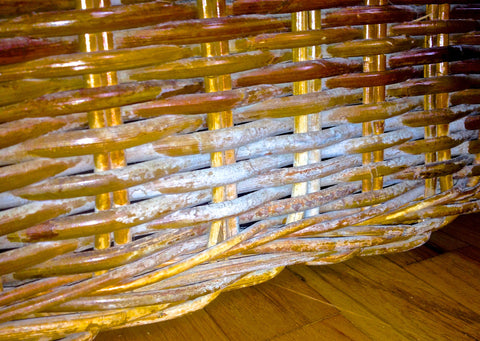How To Stop Wicker Basket Going Mouldy?- A Comprehensive Guide

Wicker baskets are charming additions to any home, but they can quickly become breeding grounds for mold if not properly cared for. If you use them for storage, decor, or both, keeping wicker baskets mold-free is important for maintaining their beauty and functionality.
In this guide, we'll explore practical tips to prevent wicker baskets from succumbing to mold and ensure they stay fresh and clean for years to come.
Understanding the Causes of Mold

Before diving into prevention methods, it's crucial to understand why wicker baskets are prone to mold growth. Moisture and Lack of Air Circulation are the primary culprits behind mold formation in wicker. When baskets are exposed to damp conditions or stored in poorly ventilated areas, moisture becomes trapped within the wicker fibers, creating an ideal environment for mold spores to thrive.
➤ Moisture Control
To combat mold growth effectively, controlling moisture levels is paramount. Proper Storage plays a significant role in preventing moisture buildup. Avoid placing wicker baskets in areas prone to high humidity, such as basements or bathrooms. Instead, opt for well-ventilated spaces with adequate airflow.
➤ Cleaning and Maintenance
Regular Cleaning and Maintenance are essential for keeping wicker baskets mold-free. Dust and debris can accumulate on the surface, trapping moisture and promoting mold growth. Use a soft brush or vacuum cleaner attachment to remove dirt and dust from the basket's surface regularly. Additionally, wipe down the baskets with a damp cloth soaked in a mild detergent solution to remove any stubborn stains or residue.
Natural Mold Prevention Methods
While commercial mold inhibitors are available, many prefer natural alternatives for mold prevention, especially for items used in food storage or around children and pets. Natural Remedies such as vinegar, baking soda, and essential oils can effectively inhibit mold growth without introducing harmful chemicals into your home environment.
1. Vinegar Solution
White vinegar is a versatile household ingredient known for its antibacterial and antifungal properties. Create a Vinegar Solution by mixing equal parts white vinegar and water in a spray bottle. Lightly mist the wicker baskets with the solution, ensuring thorough coverage. Allow the baskets to air dry completely before returning them to their storage space.
2. Baking Soda Paste
Baking soda is another natural deodorizer and mild abrasive that can help prevent mold growth on wicker baskets. Baking Soda Paste can be made by mixing baking soda with water to form a thick paste. Apply the paste to the affected areas of the basket, gently scrubbing with a soft brush. Rinse the baskets with clean water and allow them to dry thoroughly.
3. Protective Coatings
Applying Protective Coatings to wicker baskets can provide an additional layer of defense against mold and moisture. Natural oils such as linseed or tung oil can penetrate the wicker fibers, creating a barrier that repels moisture and inhibits mold growth.
4. Linseed Oil
Linseed oil is derived from the flaxseed plant and is prized for its water-repellent properties. To apply Linseed Oil, first, ensure the wicker basket is clean and dry. Using a soft cloth or brush, evenly coat the surface of the basket with linseed oil, allowing it to penetrate the fibers. Wipe off any excess oil and allow the basket to dry completely before use.
Conclusion
Preventing wicker baskets from going moldy requires proactive measures to control moisture and promote airflow. By implementing regular cleaning routines, utilizing natural mold prevention methods, and applying protective coatings, you can ensure your wicker baskets remain pristine and mold-free. Remember, a little maintenance goes a long way in preserving the beauty and functionality of these timeless home accents. So, take the necessary steps today to keep your wicker baskets looking their best for years to come.

